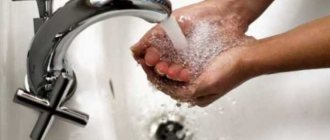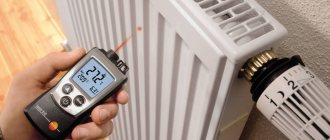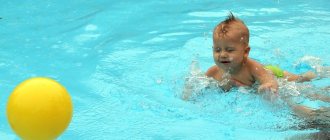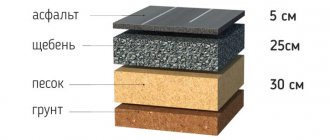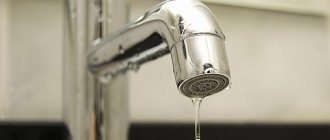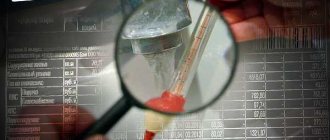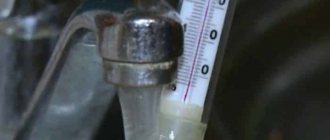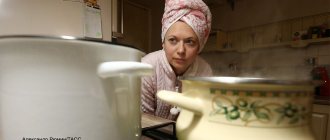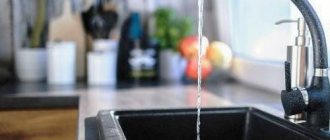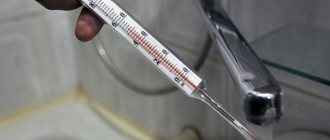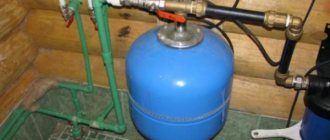Among all utilities, hot water is rightfully considered the most important. However, not everyone has access to it.
Also, the supplied water does not always meet all the necessary SanPiN standards. The most common discrepancy is the temperature of the supply water.
Dear readers! Our articles talk about typical ways to resolve legal issues, but each case is unique. If you want to find out how to solve your specific problem, please contact the online consultant form on the right. It's fast and free! Or call us at :
+7 Moscow, Moscow region
+7 St. Petersburg, Leningrad region
8 Federal number (free call for all regions of Russia)!
Normal temperature of hot water in the apartment
The content of the article
In accordance with currently applicable regulations, apartments of citizens connected to a centralized hot water supply system must be supplied with hot water at a temperature of at least 60°C.
These standards establish maximum permissible deviations from this minimum. So, in the period from 0-00 to 5-00 the deviation can be 5°C, and in the remaining time, the maximum deviation can be 3°C.
Thus, taking into account the maximum permissible deviations, the temperature of hot water during the day cannot be lower than 57°C, and at night - 55°C.
Established standards
According to the above standard, the hot water temperature should be:
- for open systems – from +60 °C;
- for closed systems – from +50 °C.
Regardless of the heating system, the water temperature should not exceed 75 degrees. Compliance with these standards ensures the protection of the aquatic environment from the effects of harmful bacteria. Exceeding the temperature may damage plastic water pipes.
The deviation from the specified values at night should be within 5 degrees, and during the day - 3 degrees.
Hot water temperature standards according to SanPin
SanPiN 2.1.4.2496-09, which were approved by the Decree of the Chief State Sanitary Doctor of the Russian Federation dated 04/07/2009 No. 20, set the minimum temperature of hot water supplied to apartments at 60°C. The same document also defines its maximum possible temperature, which is 75°C.
In addition, the above document also defines the maximum permissible deviations from these indicators. They are 5°C at night and 3°C during the day. It should be emphasized that these standards are designed to exclude the possibility of the proliferation of harmful microorganisms in hot water supply systems.
Experts, when calculating what temperature hot water should be, took this point into account. At the same time, hot water flowing from the tap should not cause thermal burns to the skin.
The powers to monitor the extent to which management and resource supply companies comply with these standards are assigned to the state housing inspection.
Separately, we emphasize that resource supply, and especially management companies, do not have the right to establish their own standards that differ from those contained in SanPiN 2.1.4.2496-09.
What temperature should the water be in the apartment building?
The optimal temperature regime for water in an apartment is established by the Government and approved by the Chief Sanitary Doctor of the Russian Federation .
Standards for hot water supply today indicate that water must be supplied to rooms at a temperature of at least 60°C.
This value includes deviations from the norm that are acceptable. At night, the difference with this indicator can be no more than 5°C. At night the deviation is 3°C.
If the maximum water temperature is not observed during the day, the citizen has the right to submit an application to reduce the amount of payments . The amount will be reduced by 0.1% for each hour the deviation occurs. If the water temperature in the house drops to 40°C, then you will not need to pay for hot water supply.
Please note: for calculating payments, tariffs similar to those for cold water are used. If the norm is not observed, then a special act will need to be drawn up to confirm the fact of violation. It records the fluctuations in water temperature that occur during the day.
Legal basis
Standards for DHW temperature are prescribed at the official level. SanPiN 2.1.4.2496-09 is used in this direction. This act reflects what indicators will be normal for hot water.
The provisions of clause 2.4 indicate that at the point of water intake the temperature should be:
- lower limit - 60°C;
- limit values - 75°C.
It does not take into account what type of water supply system is used in the house. These indicators are set to ensure that residents do not develop skin diseases. The reason is the use of low quality water. In addition, compliance with such a regime helps ensure the epidemiological safety of citizens.
Correct temperature measurements
What hot water temperature is defined in Government Decree No. 354 of 2011 “On the provision of public services...”.
If a citizen is sure that water is supplied to the apartment in violation of these rules, he needs to write a statement to the Criminal Code . Otherwise, measurements taken independently are not given legal force.
Therefore, you need to call the employees of the authorized company and ask them to draw up a report. It reflects the measurements taken and violations of established standards.
To measure the water temperature in the premises you need to do the following:
- turn on the hot water and wait about 3 minutes until the temperature stops fluctuating;
- place a container under the tap and wait for it to start flowing over the edge (you need to use an item with a volume of 1 liter or more);
- place the thermometer in the vessel;
- wait for the result to be recorded and remove the device.
To find out what the temperature is in the tap, you should take measurements without turning off the water. Otherwise, the liquid will quickly cool down.
Permissible deviation of water temperature at the point of water intake
The maximum possible deviations from the established minimum and maximum hot water temperatures are established in the Decree of the Government of the Russian Federation of May 6, 2011 No. 354 “On the provision of utility services to owners and users of premises in apartment buildings and residential buildings”:
- during the period from 0-00 to 5-00, the maximum possible deviation is set within 5°C;
- during the period from 5-00 to 0-00, the maximum deviation is set within 3°C.
If the temperature of hot water goes beyond the above deviations, then for every 3°C, you have the right to demand a reduction in the cost of hot water by 0.1% for each hour of time during which the deviation lasts.
If the temperature of the water flowing from the hot tap is less than 40°C, then you have the right to pay for it at cold water supply rates. However, for this you should draw up and properly execute an act in which this deviation will be recorded.
Minimum indicator. As mentioned above, hot water should not be colder than 60°C. However, taking into account the maximum possible deviations, its temperature can be 57°C during the day and 55°C at night.
Current legislature
Legal standards set out very clearly the requirements for hot water supply in multi-apartment residential buildings. They are set out in two main regulations.
This:
- approved by Decree of the Government of the Russian Federation No. 354 of 05/06/11 “Rules for the provision of utility services to owners and users of premises in apartment buildings and residential buildings.” Appendix No. 1 – “Requirements for the quality of public services”,
- Sanitary and epidemiological rules and norms approved by the Resolution of the Chief State Sanitary Doctor. Abbreviated as SanPiN 2.1.4.2496-09 “Hygienic requirements for ensuring the safety of hot water supply systems.”
Important! According to these regulations, hot water supplied to housing must meet the following requirements:
- be no lower than + 60 and no higher than + 75 degrees, regardless of the heating system installed in the residential building,
- To measure the temperature of the supplied water, you must leave the tap open for three minutes and only then take measurements.
Depending on the time of day, the following permissible temperature deviations are possible:
- from 0.00 a.m. to 5.00 a.m. – no more than 5 degrees in one direction or another,
- from 5.00 am to 00.00 am - such a deviation is permissible by no more than 3 degrees.
If water is supplied at the appropriate temperature, then consumers pay its cost at the full rate.
If the water temperature does not meet the stated requirements, then you should pay based on the following:
- at temperatures below 40 degrees, payment is made as for cold water. However, for this it is necessary to record this fact. Draws up a corresponding act with a call from a representative of the heat supply organization,
- for water supply whose temperature is above 40 degrees, but below 60, the payment tariff is reduced by 0.1 percent for each hour of water supply at this temperature. Again, this fact must be recorded with the drawing up of an act.
Hot water temperature value
You should monitor the temperature of the water flowing from the hot tap not only for economic reasons, but also for reasons of epidemiological safety.
This point is especially relevant for young children, elderly disabled people and other groups of citizens. In order not to jeopardize the life and health of citizens, the water temperature should not deviate from the established standards more than the maximum possible deviations, either downward or upward.
Having water temperature within established standards is not just a matter of comfort, but also of sanitary and epidemiological safety of citizens.
Sometimes, although this happens quite rarely, the water temperature can significantly exceed the established standards. This deviation creates a risk of thermal damage to the skin. To prevent this from happening, you should know what consequences exposure to hot water of a certain temperature can have on the skin:
- +50°C – when the skin is exposed to water at this temperature for more than 1.5 minutes, a minor thermal burn of the skin may occur;
- +55°C – when exposed to water at this temperature, a skin burn may occur within 15 seconds;
- +60°C – thermal damage to the skin will occur when exposed for 5 seconds;
- +65°C – severe thermal damage to the skin will occur with exposure lasting 2 seconds;
- +70°C – when the skin is exposed to water at this temperature, severe thermal damage occurs instantly.
Cases when water flows from a hot tap, the temperature of which is significantly lower than the standard temperature, are very common. This not only leads to an increase in its consumption and, as a consequence, financial costs for paying for poorly rendered services, but also makes it possible for the development of many negative situations.
For example, in a hot water supply system, in the event of a significant decrease in water temperature, the most favorable conditions are created for the life and development of various harmful microorganisms that can cause a number of diseases in humans.
Most often, in such conditions, the Legionella bacterium begins to develop. Warm fresh water is the most favorable environment for its life and reproduction. This pathogenic bacterium is a gram-negative rod, the size of which does not exceed 3 microns.
Underheating of the water entering the hot water supply system leads to the creation of the most favorable environment for Legionella in pipes and boilers.
As a result, they begin to develop rapidly and form huge colonies. This, in turn, poses a significant threat to human health.
The optimal habitat for these pathogenic bacteria is warm, fresh water. It is for this reason that they quite often infect low-temperature heating systems, where they create entire colonies.
Legionella can cause many diseases, the most severe of which is pneumonia with various complications.
This bacterium can enter your body during a bath or shower, while performing various hygiene procedures, as well as from dishes that were washed with contaminated water as a result of underheating.
When the water is heated to the temperatures established by current standards, then bacteria have no chance to survive and multiply, which means the likelihood of your infection is reduced to almost zero. For water to undergo complete thermal disinfection, it must be heated to at least 80°C.
Let's look at how water temperature affects the development and activity of Legionella:
- At a water temperature of less than 20°C, the bacterium loses its activity, it stops reproducing, enters suspended animation, but does not die;
- Water, the temperature of which ranges from 25 to 45°C, is the most favorable environment for the habitat, life and reproduction of this bacterium;
- If the water temperature remains at 55°C for 6 hours, these bacteria will die;
- If the water temperature is 60°C, then legionella colonies will be destroyed within 35 minutes;
- When the water temperature rises to 65°C, the bacteria die within 2 minutes;
- At a water temperature of 70 to 80°C, complete thermal disinfection of water occurs.
Calculation coefficient for hot water in case of non-compliance with the standard
Having information about what temperature, according to current standards, hot water should be, you need to find out the coefficient that should apply to calculate the payment for it if the temperature of hot water deviates from the established standards.
If you find that the temperature of the water supplied to you as hot does not meet the approved standards, you have every right to demand a recalculation.
We emphasize that if the water flowing from a hot tap has a temperature below 40°C, then you must pay for it at the rates approved for cold water supply.
And if we talk about the coefficient used for calculation, it is 0.1% of the cost for every 3°C by which the water temperature was below the established standards. However, we should not forget about the maximum permissible deviations.
Measuring the temperature of hot water in the apartment
Unfortunately, if you decide to measure the temperature of the hot water that enters your apartment on your own, it will not have legal force.
However, this does not mean that it is not worth implementing. By measuring the temperature of the hot water yourself, you will be able to understand whether you should involve independent experts in this process, or whether everything is within the normal range.
In addition, based on the results of such measurements, you will have grounds to file a complaint with the management or resource supply company.
To measure the hot water temperature, do the following:
- open the tap from which hot water flows and wait a few minutes until it drains;
- after that, find a container with a volume of at least a liter, place it in the sink and turn the tap so that hot water flows into it. Water should completely fill the container and begin to flow out of it;
- Place a thermometer designed for measuring temperature in liquids into the container into which hot water flows;
- When the thermometer readings are recorded, remove it from the water.
Based on the results obtained as a result of these actions, you will be able to understand what the temperature of the water coming to you from the hot tap is and how much it deviates from the standards and decide what actions to take next.
It is worth remembering that temperature measurements must be taken as close as possible to the place where the water comes out of the tap, since when it comes into contact with the environment, the water cools quite quickly, and this can have a significant impact on the results of your measurements.
Having realized from the results of the measurements taken that you are being supplied with very sub-cooled water, you should submit a corresponding complaint, properly formatting it, to the management or resource supply company.
Eliminating the reasons why you receive hot water whose temperature is different from the established norm is their responsibility.
Where to go if hot water is not up to standard
If the hot water temperature does not meet the standards and you want to achieve a recalculation, then you should act in accordance with the Decree of the Government of the Russian Federation dated May 6, 2011 No. 354 “On the provision of utility services to owners and users of premises in apartment buildings and residential buildings.” It is in this document that the procedure for your actions is prescribed.
Let's take a quick look at how you should proceed:
- If you find that the hot water temperature deviates significantly from the norm, you should immediately notify the manager of the management or resource supply company. In this case, notification is possible both in written and oral form;
- The dispatcher whom you notified about this fact is obliged to record your request;
- In the appeal that you submit to the dispatcher, clearly state the essence of the problem that has arisen, indicate your last name, first name, patronymic and contact information, including address and telephone number;
- The dispatcher who accepted your request must introduce himself and state his position. After he registers your appeal, you should check with him under what number it was registered;
- If the dispatcher is aware of the causes of the problem you are experiencing, he should inform you about them, as well as the measures that are being taken to eliminate them;
- If nothing is known about the reasons that caused your problems, then an appropriate check will be carried out upon your request. If necessary, the time of its holding will be agreed with you;
- Based on the results of the inspection, an appropriate act must be drawn up. It will record whether violations were identified during the inspection, the reasons that led to them, the methodology by which the measurements were taken, as well as other information;
- The above act is drawn up in two copies, one of which is given to you as the applicant, and the second remains with the organization that carried out the inspection;
- If you are not satisfied with the results of the inspection, you have the right to insist on repeating it with the involvement of independent specialists.
If an inspection is carried out with the participation of an independent specialist, the time at which it will be carried out must be agreed upon with all interested parties.
This inspection will be carried out at the expense of the management or resource supply company, however, if its results confirm the results of the previous inspection, you will have to reimburse all costs for its implementation.
What to do if the hot water supply does not meet the standards
The owner must take action, since the accrued payment presupposes the utility organization’s compliance with its obligations. Step-by-step instructions for consumer actions in this situation:
- send a written complaint to the service provider, with mandatory registration of the application;
- if the deviation from the standards is not related to malfunctions of the equipment, the date of the inspection is agreed upon;
- at the appointed time and date, a representative of the utility organization must come to the applicant’s address and check the fairness of the claims made. Based on the results of the inspection, a report is drawn up recording the specified circumstances in the number of copies according to the number of participants.
The complaint is drawn up in any form, but with the mandatory inclusion of the following information:
- the name of the organization where the paper is sent and the official recipient;
- the essence of the claims, indicating the water temperature;
- requirements to ensure compliance with regulatory parameters.
We recommend: Until what date should meter readings be submitted?
The document is signed by the applicant, indicating the current date. In order for the applicant to be able to prove the fact of filing a complaint, it is necessary to prepare two copies of the application, one of which with a receipt stamp, incoming number and date remains with the consumer.
Actions after you receive the document in your hands
Having received a report in your hands, which records the fact that the hot water temperature does not comply with current standards, you can safely request a recalculation from the management or resource supply company.
In the event that, upon your contact to the dispatcher, and even more so based on the results of a repeat inspection, no actions are taken to eliminate the causes of the problem, you have every right to file a complaint with the Federal Service for Surveillance in the Sphere of Consumer Rights Protection and well-being of a person, or file a claim with a magistrate.
How to measure temperature
Now a little about how to measure the temperature of hot water in a tap in residential buildings. It should be said that the results of measurements carried out by residents are not proof that management companies provided poor quality utility services. But in any case, after independent measurement, you can make sure whether the quality of the supplied water meets the conditions that suppliers are required to supply to the apartments of a multi-storey building according to current standards, and the temperature of hot water in the water collection points will also be determined. This is necessary to file a complaint with the relevant authorities when the hot water is not up to standard.
The sequence of independent measurements is as follows:
- You need to open the tap and let the water drain for about three minutes.
- Take any container of at least 1 liter and fill it with water that flows from the tap.
- Take a temperature meter and insert it into the hot liquid closer to the base.
- Wait until the mercury stops on the thermometer and remove it from the container.
From these measurement results it can be determined whether the detected value corresponds to the recommended values. You should know that the measurement is carried out only at the water tap point (where the water comes out of the mixer). No measurements should be taken at other points, since the degrees drop there, and this is the concern of resource supply and management companies.
As a result, there is no need to provide employees of the management organization with excuses to blame all these issues on the residents of the building, because sanitary standards for the temperature of hot water in apartments are enshrined in the laws, and the causal connections between the owners and tenants of apartments do not concern them. The main thing that residents need is to be aware of who to write an application for recalculation of payments for housing and communal services that were provided poorly.
IMPORTANT! Research that determines the standard temperature of hot water in an apartment should be entrusted to an accredited company that has license certificates authorizing such activities.
How to write a complaint about low hot water temperature
This complaint can be typed on a computer or written by hand.
The main thing is that it must contain the following data:
- In the upper left corner, provide information about yourself, including your full name, residential address and contact phone number;
- Below, indicate which organization you are contacting and, if possible, which of its officials;
- Once this above information is included in the header of the document, you should begin writing the main part of the complaint. In it, describe the essence of your problem in as much detail as possible. Tell her where and when you have already contacted her, and what kind of reaction there was to your request. It is advisable in this part to make references to regulations;
- When the main part of the complaint is written, you should list all the documents and materials that you consider necessary to attach to it;
- After this, the complaint is sealed with your handwritten signature and date.
Initially, such a complaint should be filed with the management or resource supply company. If you are refused to consider it or simply left without an answer, contact the Federal Service for Surveillance on Consumer Rights Protection and Human Welfare. You can also submit it to the Prosecutor's Office, or file a claim with the judicial authorities.
How to write a complaint addressed to the head of the company
Complaints filed by consumers to various authorities do not have a uniform form. And the current legislation does not impose any requirements for the preparation of such a document.
The law determines that in order to protect his violated rights, the consumer has the right to file a complaint with the appropriate response authority.
As practice shows, a written complaint is presented in free form.
Recalculation of housing and communal services, if I do not live in an apartment.
complaints addressed to the head of the company for free in word format
However, for the sake of completeness, it contains the following data:
- name of the organization or institution to which the document is submitted,
- position, surname and initials of the manager to whose name the complaint is addressed,
- name of the locality, name of the street, number of the building where the specified addressee is located,
- surname, name, patronymic and place of residence of the citizen who applies,
- name of the document “Complaint”,
- date of conclusion of the contract for hot water supply,
- the obligations of the parties are to supply water at the appropriate temperature for the supplier and timely payment for the consumer,
- the essence of the violation, when, by whom and how the fact of a violation in the hot water supply was recorded,
- legal grounds for filing a complaint,
- stated requirements,
- Attached documents,
- date, signature, surname and initials of the consumer.
Attention! The complaint is drawn up in several copies, one for each addressee, if there are several of them, and one remains with the applicant. The document is submitted to the office of the hot water supplier for signature and registration, which is noted on the consumer’s copy.
If they refuse to accept the complaint or do not want to register it, it is better to send the document by mail. To do this, use a registered letter with a list of attachments and a notification of delivery.
Recalculation of payment for water of inadequate quality
How to achieve recalculation if the temperature of the water from the hot tap does not meet the standards?
Having received a report that records the deviation of the hot water temperature from the established standards, contact the management or resource supply company and ask for a recalculation. At the same time, you must clearly define for what specific time period it should be carried out.
It is customary to take the date indicated in the act as the beginning of this period. The end date of the period is the date when, after eliminating the causes that led to your problem, final measurements were taken.
If you are denied a recalculation, file a complaint with the Federal Service for Supervision of Consumer Rights Protection and Human Welfare or file a claim with the judicial authorities.
In accordance with Article 7.23 of the Code of Administrative Offenses of the Russian Federation, persons whose guilt in non-compliance of hot water temperature with established standards is proven may be subject to administrative punishment.
Officials may be fined from 500 to 1,000 rubles, and for legal entities the fine may be from 5,000 to 10,000 rubles.
Everyone who pays for utilities wants them to be provided at the proper level. Therefore, you should not put up with a situation where the quality of utility services provided to you does not meet established standards.
Is compensation due?
If the information contained in the complaint is confirmed, the utility company must reduce the assessed fee in the amount of 0.1 percent. If it is revealed that the temperature readings are no more than 40 degrees, payment is calculated according to cold water supply standards.
The consumer must understand that the responsibilities of utility services include compliance with the conditions specified in the contract concluded with the consumer and the values of parameters in accordance with approved standards. Otherwise, the consumer has the right to demand a recalculation by filing a complaint with the utility organization.
If the energy supplier refuses to recalculate, if there are documents confirming the validity of the claims, the home owner has the right to file a claim with the court or other state regulatory authorities.
Proposed changes in standards for the provision of hot water supply
Increasingly, resource supply companies are raising the question that the standard hot water temperature needs to be reduced to 60°C.
They also contact the Federal Service for Supervision of Consumer Rights Protection and Human Welfare with a proposal for such a reduction. They justify this proposal by the need to save energy.
To do this, they offer two options on how to achieve such savings:
- According to the first, it is proposed to replace thermal disinfection of water with disinfection using special means. Those promoting this option argue that disinfection using special means will be more effective and will ensure that end consumers are not infected;
- Proponents of the second option suggest reducing the temperature of hot water to 50°C, and for thermal disinfection, warming it up to 70°C once a day. Experts promoting this option try to refer to supposedly existing world experience, arguing that this method will not only allow for thermal disinfection, but also reduce the number of thermal injuries among consumers.
However, these two very dubious options have many opponents.
By way of objection, they argue:
- First of all, in resolving this issue it is necessary to find out the opinion of the consumers themselves. After all, the proposed changes will primarily affect their interests. The proposed measures can have a significant impact on comfort. But the fact that they will save money raises serious and very reasonable doubts. It is unlikely that energy supply companies, having started spending less on heating, will reduce tariffs for end consumers. Thus, they will increase their profits, and the situation of the end user may only worsen;
- In addition, an analysis of cases in the housing and communal services system clearly shows that if the minimum temperature of hot water is lowered, we risk receiving hot water at the inlet, the actual temperature of which will be 40-45°C;
- In addition, since resource supply companies have different financial capabilities in different regions of our homeland, we may be faced with a situation where many of them will not be able to purchase expensive products for chemical disinfection, and thermal disinfection will no longer be carried out. Thus, the end consumer will not be protected from possible infection.
Thus, it is thermal disinfection, in today’s realities of our country, that is the most effective method that guarantees that harmful microorganisms cannot develop in the hot water supply system and lead to infection of the end consumer.
Fortunately for us, the idea of changing the current regulations was not approved by the Government. But apparently, resource supply companies will not give up their attempts to achieve their introduction.
Housing and communal services in Russia, all hot water temperature standards
In chronological order of their publications. The headings of inactive (cancelled) regulations are crossed out. For an abbreviated list, see the end of the file.
INTERNAL WATER PIPELINE AND SEWERAGE OF BUILDINGS SNiP 2.04.01-85*
see the current Code of Practice SP 30.13330.2012
... 2.2. The temperature of hot water at water intake points should be provided:
- a) not lower than 60 °C - for centralized hot water supply systems connected to open heat supply systems;
- b) not lower than 50 °C - for centralized hot water supply systems connected to “closed heat supply systems;
- c) not higher than 75 °C - for all systems specified in subparagraphs “a” and “b”.
Set of rules SP 30.13330.2012
"INTERNAL WATER PIPELINE AND SEWERAGE OF BUILDINGS"
Updated version of SNiP 2.04.01-85*
- “...5.1.2. The temperature of hot water at water collection points must comply with the requirements of SanPiN 2.1.4.1074 and SanPiN 2.1.4.2496-09 and, regardless of the heat supply system used, must be no lower than 60 °C and no higher than 75 °C.”
SanPiN 4723-88 “SANITARY RULES FOR THE CONSTRUCTION AND OPERATION OF CENTRALIZED HOT WATER SUPPLY SYSTEMS”
see current SanPiN 2.1.4.2496-09
(approved by the Chief State Sanitary Doctor of the USSR in November 1988)
- “...1.7. The temperature of hot water in water supply points, regardless of the heat supply system used, must be no lower than 60°C and no higher than 75°C.
Note. For a hot water supply system made of galvanized pipes with a closed heating system, it is allowed to have a water temperature of no lower than 50°C and no higher than 60°C. Under these conditions, after carrying out repair work or eliminating emergency situations in the systems, it is necessary to maintain the temperature at 75°C for 48 hours.”
GOST R 51617-2000.
HOUSING AND COMMUNAL SERVICES. GENERAL TECHNICAL CONDITIONS
- “... 4.16.3 The temperature of hot water at consumers’ water collection points should be from 50 to 75 °C [20. SanPiN No. 4723-88 Sanitary rules for the design and operation of centralized hot water supply systems ]
HYGIENIC REQUIREMENTS FOR ENSURING THE SAFETY OF HOT WATER SUPPLY SYSTEMS
"1. Application area
- 1.1. Sanitary and epidemiological rules and regulations establish hygienic requirements for water quality and the organization of centralized hot water supply systems (hereinafter referred to as DHW), as well as rules for monitoring the quality of water supplied to DHW, regardless of departmental affiliation and forms of ownership.
- 1.2. These sanitary rules are mandatory for all legal entities and individual entrepreneurs whose activities are related to the organization and (or) provision of centralized hot water supply systems...
2. General provisions
- …2.3. Sanitary and epidemiological requirements for centralized hot water supply systems are aimed at:
- - prevention of contamination of hot water with highly contagious infectious pathogens of viral and bacterial origin that can reproduce at temperatures below 60 degrees, including Legionella Pneumophila;...
- 2.4. The temperature of hot water in water collection areas, regardless of the heat supply system used, must be no lower than 60 C and no higher than 75 C.
3. Requirements for the design, construction, operation of centralized hot water supply systems
3.1.10. When operating the DHW, the water temperature at the water intake points should not be lower than + 60 ° C, the static pressure is not less than 0.05 mPa, with pipelines and water heaters filled with tap water….
“RULES AND STANDARDS FOR TECHNICAL OPERATION OF HOUSING STOCK”
(approved by the Post of the State Construction Committee of the Russian Federation dated September 27, 2003 No. 170)
“... 5.3. Hot water supply
- 5.3.1. ... The temperature of water supplied to water points (taps, mixers) must be at least 60 degrees. C in open hot water supply systems and at least 50 degrees. C - in closed. The water temperature in the hot water supply system must be maintained using an automatic regulator, the installation of which in the hot water supply system is mandatory. The water temperature at the outlet of the water heater of the hot water supply system must be selected from the condition of ensuring the normalized temperature at the water supply points, but not more than 75 degrees. WITH."
RULES FOR PROVIDING PUBLIC SERVICES TO CITIZENS
(Approved by Decree of the Government of the Russian Federation of May 23, 2006 No. 307)
see current Post. No. 354
…P. 5 Ensuring the temperature of hot water at the point of analysis:
- not less than 60°C – for open centralized heating systems;
- not less than 50°C – for closed district heating systems;
- no more than 75°C - for any heat supply systems"
RULES FOR THE PROVISION OF PUBLIC SERVICES
TO OWNERS AND USERS OF PREMISES IN MULTIPLE-Apartment BUILDINGS AND RESIDENTIAL BUILDINGS
(Approved by Decree of the Government of the Russian Federation of May 6, 2011 N 354)
REQUIREMENTS
to the quality of public services
5. ...Ensuring compliance of the hot water temperature at the point of water collection with the requirements of the legislation of the Russian Federation on technical regulation (SanPiN 2.1.4.2496-09)
PS There is an interesting document: “DECISION OF THE SUPREME COURT OF THE RF OF MAY 31, 2013 N AKPI13-394”, which, among other things, establishes:
“SanPiN 2.1.4.2496-09, as follows from the content of its paragraphs 1.1 and 1.2, establishes hygienic requirements for water quality and the organization of centralized hot water supply systems (hereinafter referred to as DHW), as well as rules for monitoring the quality of water supplied to DHW, regardless of departmental affiliation and forms of ownership, and is mandatory for execution by all legal entities and individual entrepreneurs whose activities are related to the organization and (or) provision of centralized hot water supply systems.
According to the specified SanPiN, the temperature of hot water in places of water supply, regardless of the heat supply system used, must be no lower than 60 °C and no higher than 75 °C. These sanitary and epidemiological requirements for centralized hot water supply systems are aimed, among other things, at preventing contamination of hot water by highly contagious infectious pathogens of viral and bacterial origin that can multiply at temperatures below 60 degrees, including Legionella Pneumophila, as well as at preventing skin diseases and subcutaneous tissue, due to the quality of hot water (clauses 2.3 and 2.4).
Thus, the sanitary and epidemiological rules define the requirements for the quality of hot water supplied to consumers when providing public hot water supply services according to an indicator that ensures its safety, such as temperature. This indicator is characterized by a minimum (not lower than 60 °C) and a maximum limit (not higher than 75 °C) and does not allow deviations from the specified temperature regime , subject to which the quality of the utility service is ensured.”
The temperature of hot water in water collection areas, regardless of the heat supply system used, must be no lower than 60 C and no higher than 75 C.
BASES:
clause 5.1.2 SP 30.13330.2012 “ Internal water supply and sewerage of buildings ”
Updated version of SNiP 2.04.01-85*;
clause 2.4 SANPiN 2.1.4.2496-09 “Hygienic requirements for ensuring the safety of hot water supply systems”;
5.3.1 “ Rules and standards for the technical operation of the housing stock” (approved by the Post of the State Construction Committee of the Russian Federation dated September 27, 2003 No. 170);
Clause 5 of Appendix 1 “ Rules for the provision of utility services to owners and users of premises in apartment buildings and residential buildings” (approved by the Russian Federation Government Resolution dated May 6, 2011 No. 354).
Compiled by housing and communal services specialist Yuri Kalnin
Housing and communal services in Russia
OFFICIAL Rules for measuring water temperature in the domestic hot water system (hereinafter referred to as Tgvs) are as follows:
The time for draining hot water before measuring its temperature is set:
- paragraph 5 (note <2>) of Annex 1 “Rules for the provision of utility services to owners and users of premises in apartment buildings and residential buildings” (approved by the Decree of the Government of the Russian Federation No. 354 of May 6, 2011): “... <2> BEFORE THE DEFINITION HOT WATER TEMPERATURE AT THE WATER DISCHARGE POINT, THE WATER IS DRAINED WITHIN NO MORE THAN 3 MINUTES.”
- clause 7.5 of the Methodological Instructions MUK 4.3.2900-11 “Measurement of the temperature of hot water in centralized hot water supply systems” (approved by the Federal Service Rospotrebnadzor on July 12, 2011) it is established that when draining hot water before measuring its temperature “... The water consumption should be AT LEAST 2 LITERS PER MINUTE (determined by the time it takes to fill the measuring container).”
According to the arithmetic textbook for 1st grade: 3 min. x 2 l/min. ≥ 6 liters!
Regulatory documents, unfortunately, do not contain other rules establishing any specific volume of water that must be drained from the water collection point before measuring Tgvs.
You understand perfectly well that the more water is drained before measurement, the greater the likelihood that not the temperature of the water in the tap will be measured, but the temperature of the water in the supply line along the water path from the boiler room (from the thermal power plant) to your tap!
Personally, I believe that in order to measure T hot water, it is NECESSARY AND SUFFICIENT to drain a volume of water equal to its volume in the pipe in the apartment from the hot water riser to the tap. For a hot water pipe with a diameter of 3/4 inches (2.54 x 3/4) = 1.9 cm in length from the riser to the tap L ≈ 3 meters volume V = π *D2/ 4* L = 3.14 * 1, 92/4 * 300 = 716 cm3 ≈ 1 liter.
If the hot water circulation system is working properly, the time during which the cooled water will drain from the pipe in the apartment from the riser to the water tap with a volume of ~1 liter* is no more than 10 - 30 seconds.
But also the drained volume is 3 minutes. x 2 l/min. = 6 liters ( but no more! ), calculated by us above on the basis of clause 5 of Appendix 1 “Rules for the provision of public services...” (approved by the Russian Federation Government Resolution No. 354 of May 6, 2011) and clause 7.5 of the MUK Methodological Guidelines 4.3.2900-11 “Measurement of hot water temperature in centralized hot water supply systems” (approved by the Federal Service Rospotrebnadzor on July 12, 2011) is quite sufficient for reliable measurement of T hot water.
Practice in advance before the commission arrives to measure the hot water temperature, what kind of stream should flow from the tap so that in 3 minutes a stream of 2 - 3 liters per minute (no more!) fills the “measuring container”, i.e. simply put - a saucepan, a basin with a volume of 3 minutes. x 2-3 liters ≈ 6-9 liters! This is a very small stream.
You can measure the hot water consumption using the meter.
When measuring, time the water draining yourself - you probably have a stopwatch in your mobile phone.
Do not let the meter open the tap at full power so that the splashes fly all the way to the ceiling and you end up measuring not the temperature of the water in your tap, but the temperature of the water in the supply line at the entrance to the house, or in the boiler room (at a thermal power plant).
During one of the measurements, the meter and I grabbed the tap alternately - I decreased the water flow, she increased it. As a result, I wanted to write down in the act the actual water consumption measured by the meter and the “measuring container,” but the meter snatched the act from my hands and the commission took it away without my signature. But when at the trial the housing and communal services lawyer tried to attach this act to the case, the judge, based on my statement that “... an act without my signature in accordance with paragraph 109 of “Rules No. 354” cannot have legal force..”, refused this lawyer. So, be careful before signing the deed...
Well, how much water will be drained by the HOA meter when measuring THVS in your apartment will depend both on your “arrogance” and energy, and on the impudence and energy of the HOA meter. But it is advisable to reach an amicable, business-like agreement with the HOA meter about how much water will be drained before starting to measure the temperature.
Be prepared for the meters to show their knowledge and stick the text under your nose: “...Before taking hot water samples, you should drain the water until a constant temperature is established. The time for draining the water can be up to 10 minutes…”, set out in the same paragraph 7.5 of the Methodological Instructions MUK 4.3.2900-11.
Tell them in response that the Government Decree has greater legal force than MUK 4.3.2900-11 of Rospotrebnadzor, especially since Government Decree No. 354 was issued later.
Good luck with measuring the water temperature!
TIPS ON INTERACTION WITH METERS when measuring TGV
When hot water temperature meters arrive, do not hesitate to exercise your rights established by clause 33-g) of Rule No. 354:
“...33. The consumer has the right: ...g) DEMAND from the representative of the contractor the PRODUCTION OF DOCUMENTS confirming his identity and THE AVAILABILITY OF HIS AUTHORITY TO ACCESS THE REMEDIAL or non-residential premises of the consumer to carry out checks of the condition of the metering devices, the reliability of the information provided by the consumer about the readings of the metering devices, and taking readings of the metering devices , to inspect the technical and sanitary condition of the apartment equipment, to carry out repair work, eliminate the accident and to perform other actions specified in these Rules and the agreement containing provisions for the provision of public services (ORDER, ORDER, TASK of the contractor to send such a person for the purpose of carrying out specified inspection or other similar document);" If possible, copy the document presented, so that later you can complain to someone if, after measuring the Tgvs, the act was not drawn up and left ... "
Record “right away” all conversations with the meters on a voice recorder (nowadays, most mobile phones have a “VOICE RECORDER” function. And if your phone does not have such a function, then the meters don’t know about it and you can warn the meters “I’m turning on the voice recorder” and press any button. Recording on a voice recorder (actual or imaginary) effectively disciplines the measurers and sharply reduces their nonsense and rudeness. In addition, the recording can protect you from accusations of hooliganism or insults. They also wrote a written complaint against me that I interfered with the measurements, pulled out thermometer from the hands of specialists, insulted them, although by nature I am a person without conflict and even overly delicate.
Compiled by housing and communal services engineer Yuri Kalnin
About standards for air temperatures and hot water in apartments
In accordance with clause 5 of the “Rules for the provision of utility services to owners and users of premises in apartment buildings and residential buildings”, approved by Decree of the Government of the Russian Federation of May 6, 2011 No. 354, the beginning of the heating period should be set at an average daily outdoor temperature below 8 degrees Celsius. Celsius, and the end of the heating period - when the average daily outside air temperature is above 8 degrees Celsius for 5 days in a row. The specified period must begin or end on the day following the last day of such period.
The heating season, in accordance with the Government Decree, begins by decision of local authorities. In Ryazan, the heating season started at the end of September, but many residents complain that it is cold in the apartment. The most pressing questions for Ryazan residents remain questions about standards for air temperature in the apartment and hot water temperature. These indicators will be discussed in this article.
Indoor air temperature after the start of the heating season
In accordance with the State Standard of the Russian Federation GOST R 51617-2000 “Housing and communal services. General technical conditions”, adopted by the Decree of the State Standard of the Russian Federation dated June 19, 2000 No. 158-st (Table 3), the minimum temperature is set: corner room - 20 ° C; living room – 18°C; kitchen – 18°C; bathroom – 25°C; toilet – 18°С, combined bathroom – 25°С; bathroom with individual heating – 18°C; common washroom – 18°C; shared shower – 25°C; public restroom – 16°C; lobby, common corridor, hallway in an apartment building, staircase – 16°C; lobby, common corridor, staircase in the dormitory - 18°C; elevator room – 5°C.
To find out the air temperature in the room after the start of the heating season, you need to measure it in a certain way: place a thermometer on the inner wall of each room at a distance of 1 meter from the outer wall and 1.5 meters from the floor and measure it for 10 minutes.
In accordance with Appendix No. 1 to the “Rules for the provision of utility services to owners and users of premises in apartment buildings and residential buildings”, approved by Decree of the Government of the Russian Federation of May 6, 2011 No. 354 (hereinafter referred to as the Rules), heating must be uninterrupted and around the clock during the entire heating season. The permissible duration of a heating break is no more than 24 hours (in total) for one month; no more than 16 hours at a time - at an air temperature in residential premises from 12 to 22 degrees. No more than 8 hours at a time at a room temperature of 10 to 12 degrees, no more than 4 hours at a room temperature of 8 to 10 degrees. For every hour exceeding the specified standards, the monthly heating fee is reduced by 0.15%.
